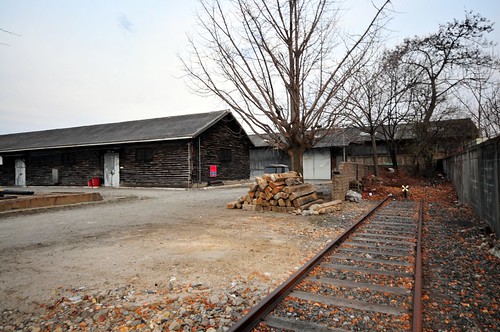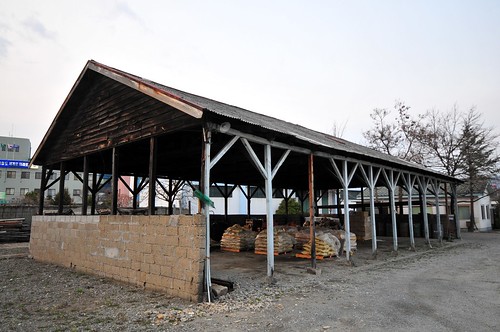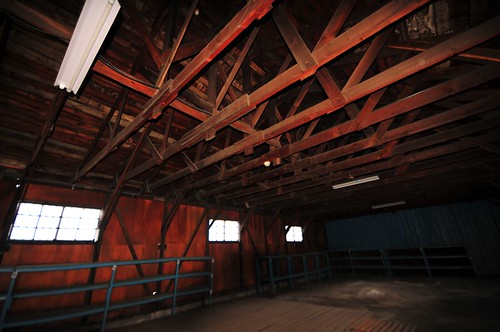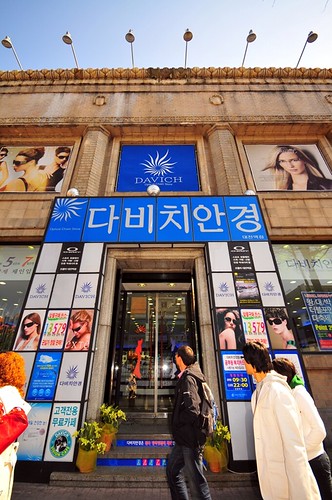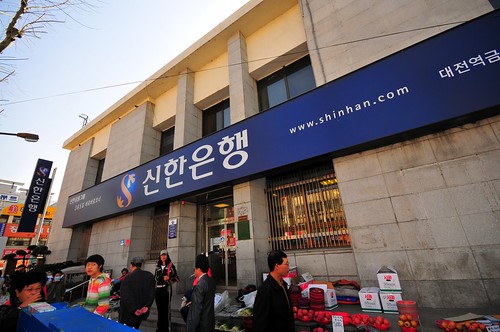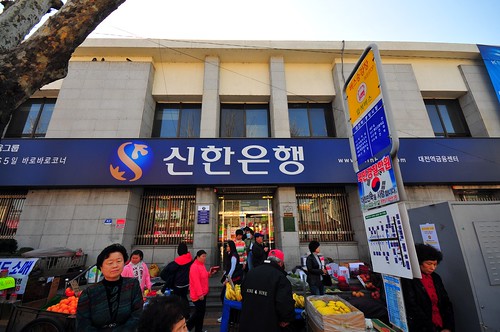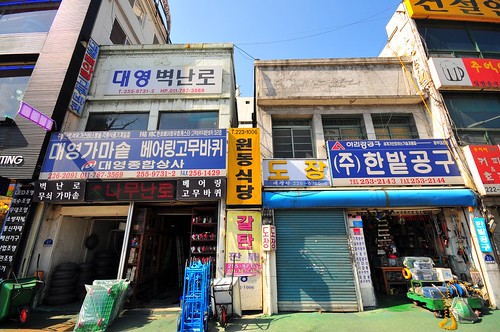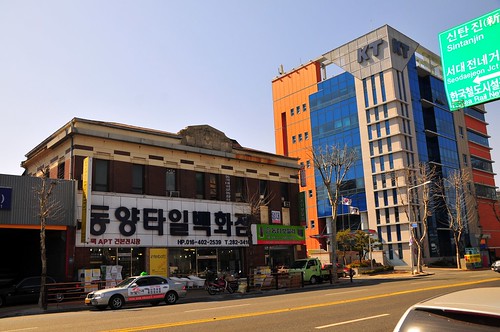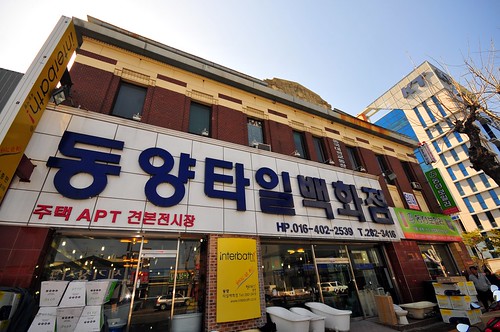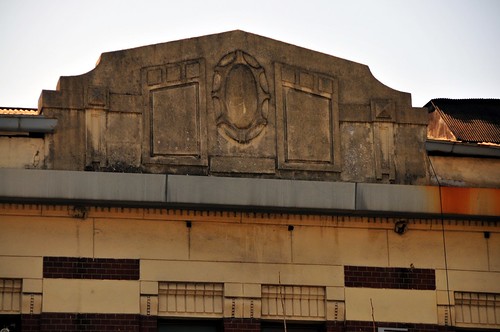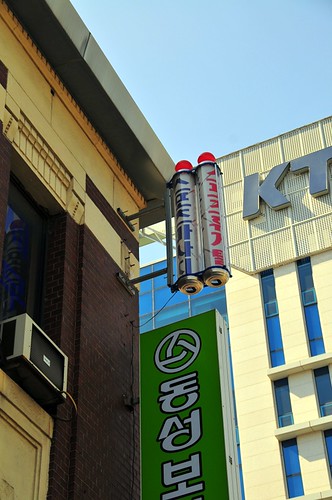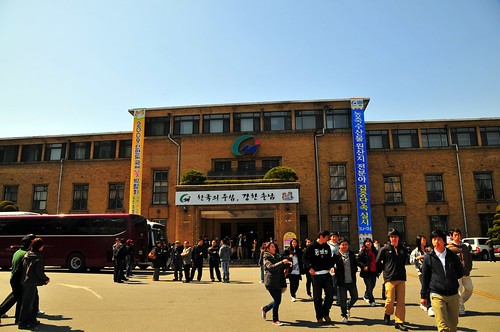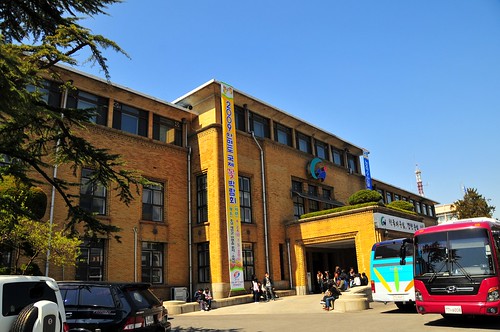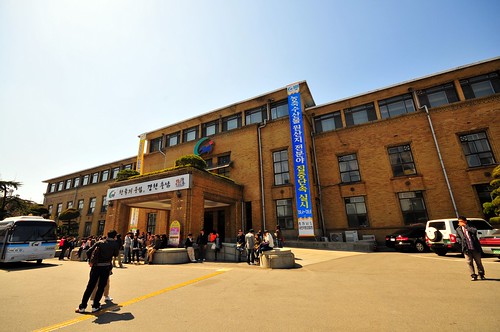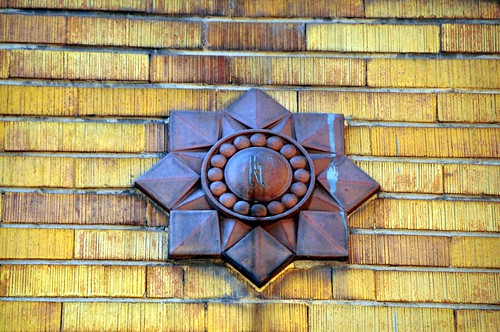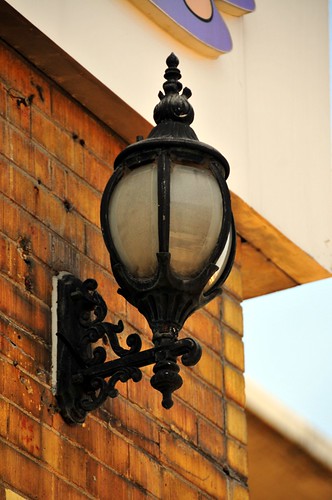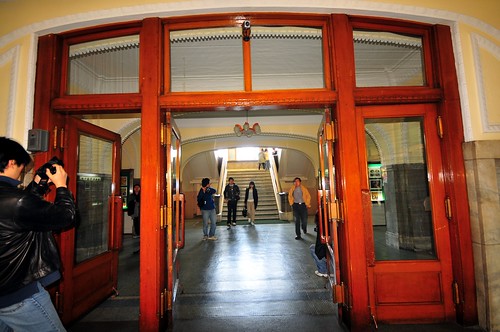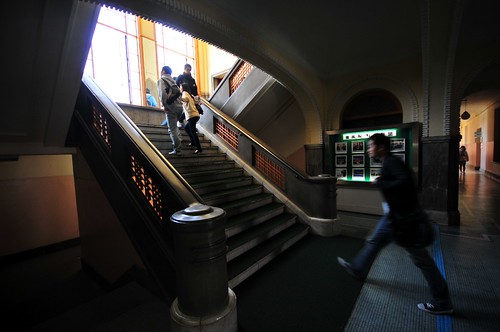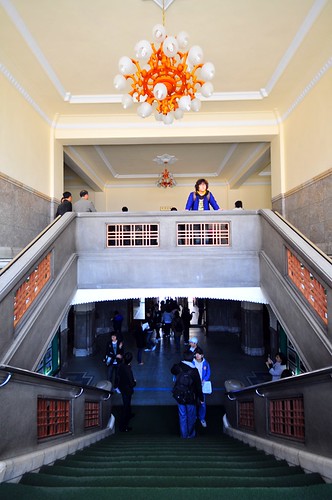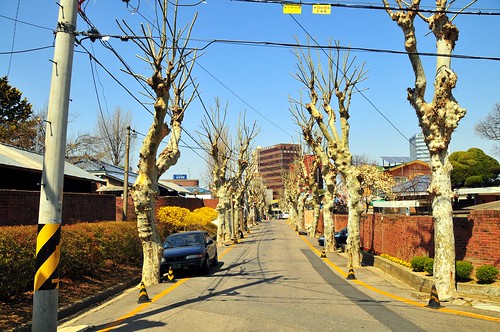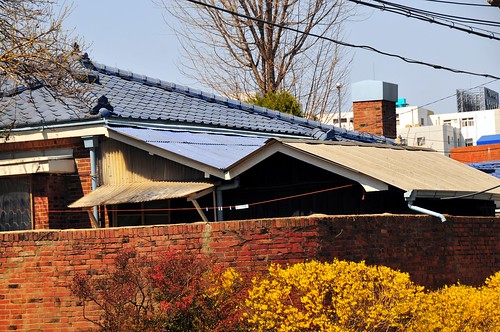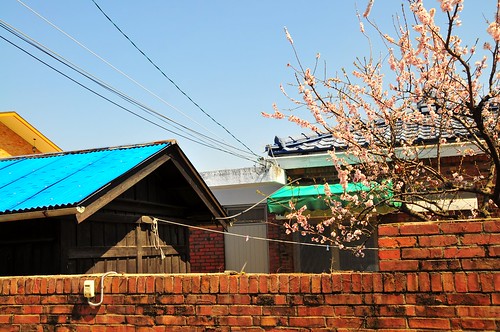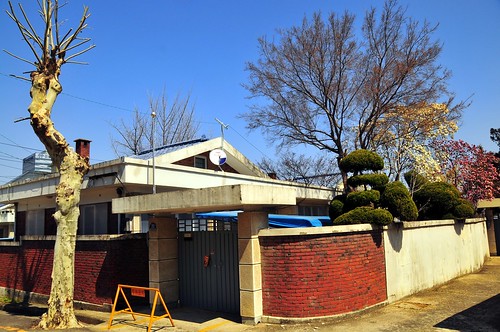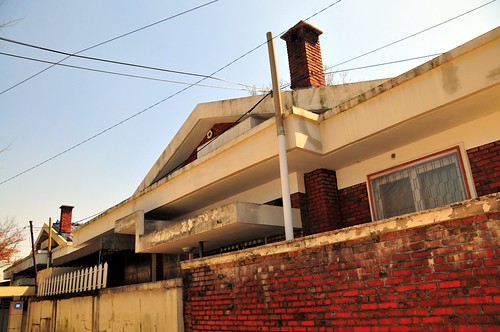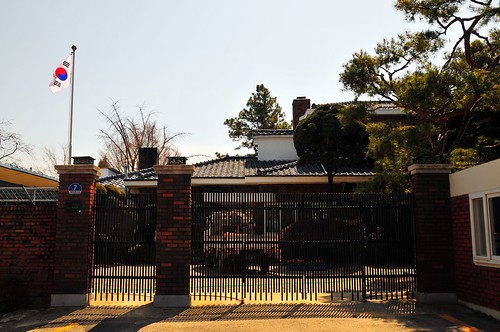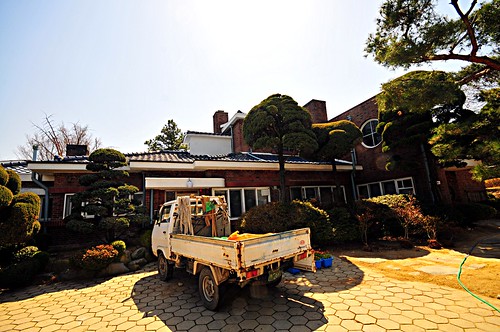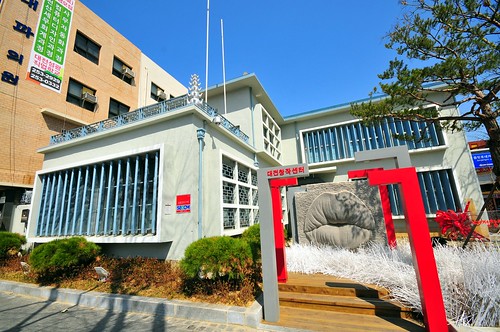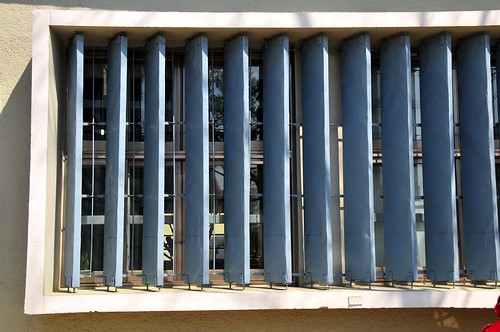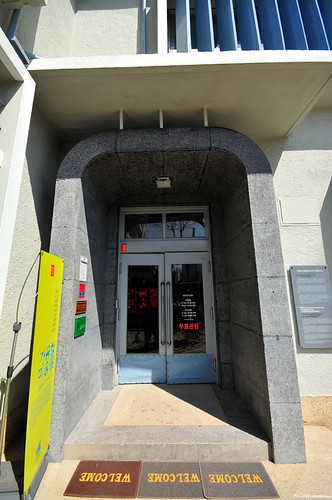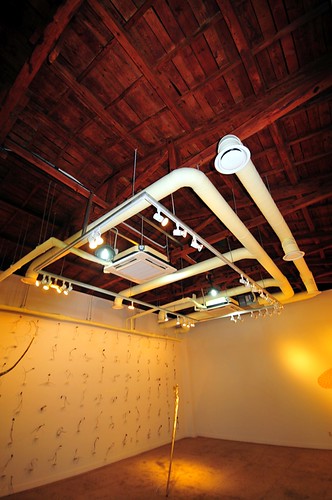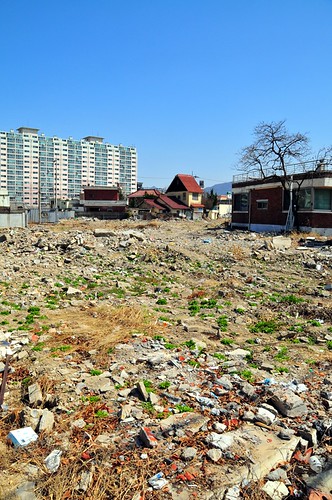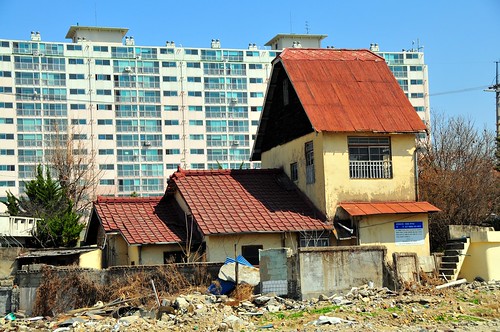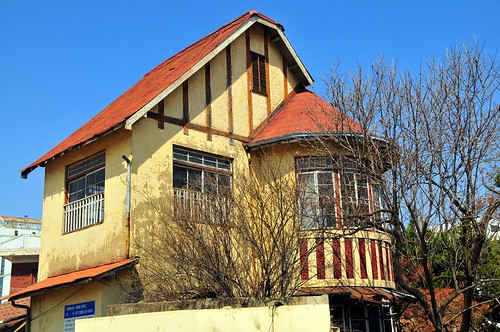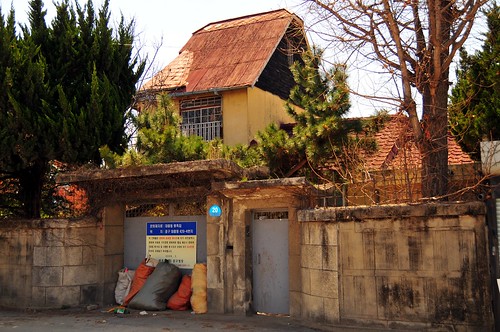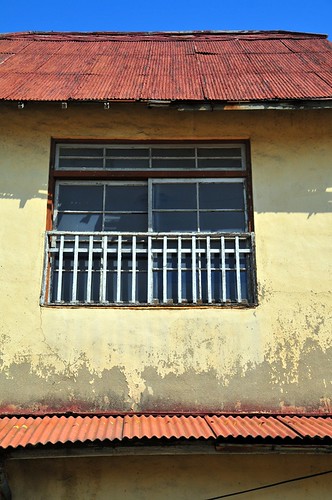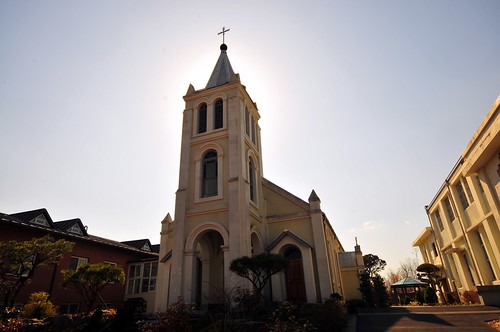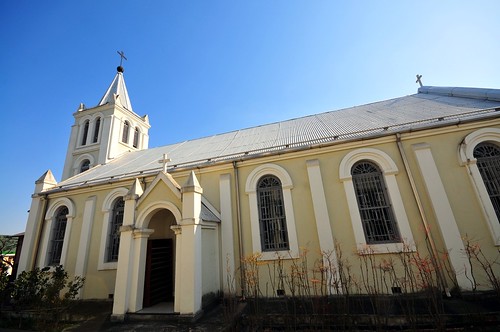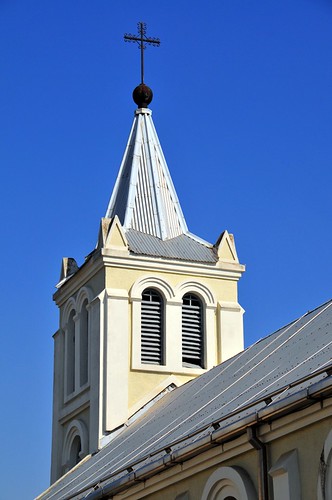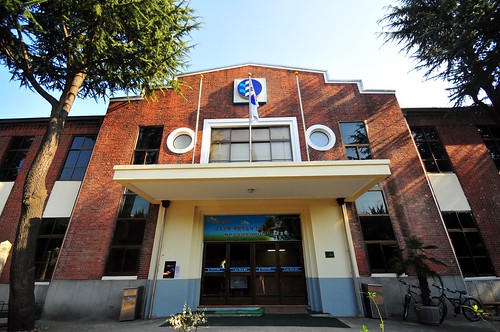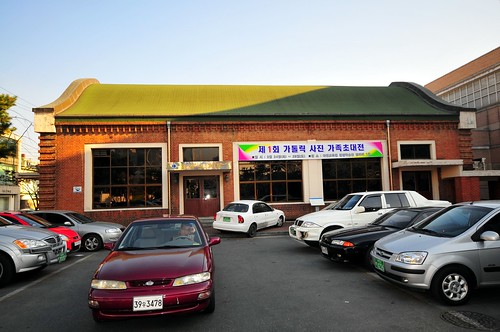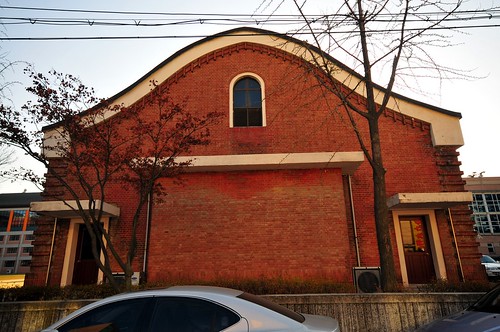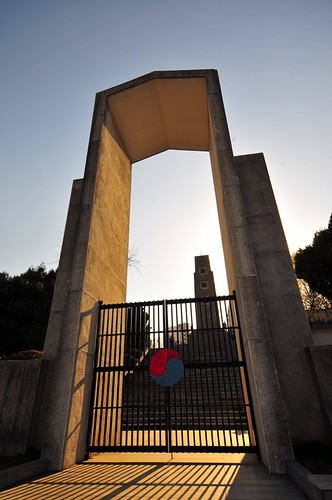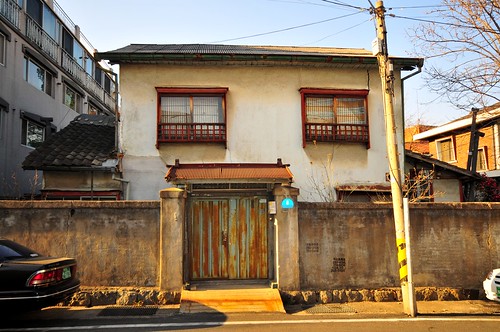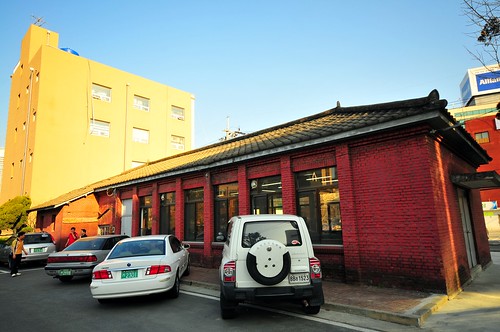Daejeon: Korea’s Railway Town
Roberts tale of DaejeonNOTE: See the Flickr slideshow here.
Just a little over a century ago, Daejeon — then called Hanbat — was nothing more than a small village in the middle of nowhere.
Then came the railroad.
Today, Daejeon is Korea’s fifth largest city, a bustling political, economic and cultural hub of 1.42 million people as of 2005. It’s also home to one of Korea’s best collections of colonial and early modern architecture, although sadly, much has been sacrificed in the name of economic development. I spent Saturday running around Daejeon’s old downtown snapping away — sites we’ll see here include:
- Daejeon’s old railway warehouses (1956)
- Former Daejeon branch of Korea Development Bank (1939)
- Former Daejeon branch of Chohung Bank (1957)
- Former Daejeon branch of the Oriental Development Company (1921)
- Chungcheongnamdo Provincial Hall (1932)
- Officials’ Village (1930s and 40s)
- Chungcheongnamdo Governor’s Residence (1932)
- Former Chungcheong Regional Office of National Agricultural Products Quality Management Service (1958)
- Daeheung-dong Pointy Roof House (1929)
- Congregation of the Sacred Word Convent Chapel (Mokdong Catholic Church) (1921)
- Old school house of Samseong Elementary School (1938)
- Old classroom of Daejeon Girls Middle School (1937)
- Seonhwa-dong War Memorial (1958?)
- Former Teacher’s College School headmaster’s residence (1930s)
Due to lack of time or unfortunate circumstances, I was unable to see certain sites, including an old red-brick power plant from 1930 (locked on weekends, although KEPCO did try to help me get in) and the old American missionary homes on the campus of Hannam University (which I blogged about in 2006).
Old Railway Warehouses
Any photo essay about Daejeon should begin with the railroad.
For all practical purposes, Daejeon did not exist prior to 1905. A small, remote village of a few dozen households called Hanbat (the pure Korean term for Daejeon, or “Big Field”) was located here, but that was it. In January of 1905, however, the Seoul-Busan railroad was completed, and Japanese settlers began flooding into the region. In 1914, the Honam Line — with Daejeon as its terminus — opened, turning the Hanbat area into a booming transportation hub. In the same year, the Japanese imperial authorities merged Hoedeok-gun, Jinjam-gun and parts of Gongju to form Daejeon.
The city expanded throughout the colonial period, both in size and population — by 1940, it was home to nearly 70,000 people. In 1932, the Japanese moved the provincial capital from Gongju to Daejeon (much to the chagrin of Gongju’s residents), cementing Daejeon’s place as the political, economic and cultural center of the Chungcheong provinces.
Daejeon today plays much the same role it did in the colonial era — it’s a major transportation hub with not just one but two KTX stations. In fact, the headquarters of KORAIL, Korea’s national railroad corporation, is located in the city. Unfortunately, not a lot of Daejeon’s railroad history remains — its beautiful old station was rebuilt in 1958, and as a major railway junction, the city — including the all-important transportation facilities — took a major beating in the Korean War, particularly during the bitter Battle of Daejeon.
One remaining part of the city railway history is three old wooden warehouses near Daejeon Station (Registered Cultural Property No. 168), maintained by KORAIL’s Daejeon regional office. Built in 1956, the railway warehouses utilize Japanese-colonial era construction techniques. Wooden railway warehouses such as these are hard to find nowadays, and give us an idea of what post-Liberation warehouse architecture was like. In the third photo, you can see the monster skyscrapers of KORAIL’s new corporate headquarters, completion of which seems to be imminent.
A word of thanks should go out to KORAIL — on weekends, the old warehouse area is usually locked up, but the guys at the Daejeon office actually called in someone on his day off to open it up so I could snoop around.
Old Banks of Daejeon
It’s said that the Chungcheong provinces are the birthplace of Korean finance, so it should come as no surprise that in Daejeon, the Queen of Chungcheong-do, we can find a number of old bank buildings in the area around Daejeon Station.
Completed in 1937, the former Korea Development Bank Building (Registered Cultural Property No. 19) is a rather typical Renaissance-style colonial bank. It’s ornately decorated with terracotta molding. As you can no doubt make out from the signboards, it’s now used as an eyeglass shop.
The former Chohung Bank (CHB) Building (Registered Cultural Property No. 20) — actually, it’s still a CHB building, CHB having merged with Shinhan in 2006 — was built in 1957, although the Daejeon branch of CHB goes back to 1912. Chohung Bank, originally Hanseong Bank, was founded in 1897 as the first commercial bank in Korea founded with Korean capital. This would sound a lot more patriotic if it weren’t founded by Kim Jong-han (1844—1932), whom the Japanese made a baron for his efforts on behalf of Japan’s annexation of Korea.
The bank building above, designed by a Korean architect after the Korean War, departs dramatically from the so-called “colonial style” banks, usually built in Renaissance-style. Instead, we have a very modern, very simple structure built on a reinforced concrete structure, with some granite adornments thrown in for good measure. As you can see above, it’s also near Jungang Market.
Just some-colonial era shop structures I passed along the way.
This is not an old bank, per se, but rather the former Daejeon branch of the Oriental Development Company (Registered Cultural Property No. 98), the Japanese answer to the British East India Company. This is a very colonial-style building for a very colonial-style company, built in Renaissance-style with some very ornate masonry.
The building is now home to, among other things, a big tile and bathroom fixtures store. If you’d like one of those heated bidet toilets, this might be a good place to come.
It’s also home, apparently, to an, ahem, “sports massage” joint. Not sure what this says about the maintenance of registered cultural properties, exactly, but some might say there’s justice in such a powerful symbol of colonial exploitation degraded so.
Chungcheongnam-do Provincial Hall
Completed in 1932, when the provincial capital was transferred to Daejeon from Gongju, Chungcheongnam-do Provincial Hall (Registered Cultural Property No. 18) is one of the best-preserved colonial-era provincial halls in Korea. It’s a massive, imposing structure that screams, “I am the Colonial Yellow Man, and you will respect my Authoritah!” Built of concrete and brick, it is covered in scratch tiles — an architectural legacy of Frank Lloyd Wright’s sojourn in Japan. Another Wright influence is the emphasis on horizontal lines. The hall was designed by the Government-General’s building department.
Here are some wonderful old photos of the Provincial Hall.
Oh, did I mention it served as a temporary home for the government during the Korean War?
As you can see, it’s an amazingly well-preserved building, including its beautiful period interior. Got to love that staircase. There was some controversy surrounding the flower designs on the exterior before a panel of experts announced that they were not symbols of the colonial regime.
With the provincial capital moving to Hongseong-Yesan, the building will soon be vacated, and authorities are still deciding how to use the stately old structure. The Korea branch of Docomomo recently held a workshop attended by a veritable who’s who of modern architecture scholars. They’re also holding a design contest as well. When I visited, there were a ton of students there on tour as part of another contest. A 2007 piece in the Daejeon Ilbo suggested the government benchmark the example of the former Hokkaido Government Buiding in Sapporo, Japan, which was restored and turned into an archive/history museum.
Sounds good to me.
So, Where Be All The Colonial Officals At?
About a 15 minute walk from the Provincial Hall, around the Taemi Pass neighborhood of Daeheung-dong, is Korea’s only remaining colonial-era gwansachon (Registered Cultural Property No. 101), a village of official residences. Basically, it’s a street lined with very similar Japanese-style homes that were built in the 1930s and 40s as residences for high-ranking Japanese officials. Oddly, though, the home they show on the Cultural Heritage Administration homepage, doesn’t seem very Japanese at all, but rather Frank Lloyd Wright/Art Deco-esque.
Where Art Deco Meets SOFA
At the head of the gwansachon, however, is the Chungcheongnam-do Governor’s Residence (Daejeon Cultural Property No. 49), built in 1932 as the residence for the colonial provincial governor. For me, this was a real treat, since the residence is, as far as I know, the only protected Art Deco building in Korea:
설계는 일본풍이지만 전통적인 한옥의 장점을 도입하고 거실·식당·방 등의 공간배치는 동선의 흐름을 중시하는 서양식이어서 전체적인 건물양식은 아르데코풍 (자연의 선을 중시한 장식미술의 한 형식으로)을 따르고 있다.
Oh yeah!
In addition to being a rare example of Art Deco in Korea, it’s also an extremely historic building. During the Korean War, it served as a temporary residence to President Syngman Rhee before he was forced to flee again to Busan. It was here that Rhee officially requested the intervention of UN forces to help repel the North Korean invasion. It was also here that on July 12, 1950 he agreed to — in the form of an exchange of diplomatic notes — the “Agreement Relating to Jurisdiction over Criminal Offenses Committed by the United States Forces in Korea Between the Republic of Korea and the United States of America,” or Daejeon Agreement. which gave US court martials exclusive jurisdiction over members of the US military. In 1966, this agreement was replaced by the ever-popular Status of Forces Agreement, or SOFA.
Like the Provincial Hall, the Governor’s Residence will soon be vacant, too — which is just as well, probably, since some local civic groups had been wondering why the governor was still living in a big colonial mansion, maintained by taxpayer money. The linked article isn’t particularly interesting, and probably reveals wrong thinking on the issue of preservation, but through it I did learn that the city halls of Geoje and Jinhae are apparently sitting on monuments to Russo-Japanese war hero Admiral Togo Heihachiro, which is both interesting and surprising.
Oh, and thanks go to the security guard who let me past the front gate for a couple of minutes to snap some shots.
Former Chungcheong Regional Office of National Agricultural Products Quality Management Service
A nice example of the proper utilization of modern cultural properties is the former Chungcheong Regional Office of the National Agricultural Products Quality Management Service (Registered Cultural Property No. 100), a striking functionalist building completed in 1958. It was designed by Bae Han-gu, the first architect to set up shop in Daejeon. It utilizes reinforced concrete slabs (a new construction technique at the time) and a series of louvers to control the sunlight. Although you can’t see it here, the roof is covered in Korean-style giwa tiles.
Built at a time when Korea was still rebuilding after the Korean War, this was an amazing piece of architecture.
In 2006, the building was renovated for use as an art gallery, a role it serves admirably. It’s a lot better than letting these historic builds rot or, even worse, tearing them down.
Daeheung-dong Pointy Roof House
This lunar landscape is what a protected modern cultural property standing in the middle of a redevelopment zone looks like.
Built in 1921, this fantastic residence — called the Daeheung-dong Ppyojok-jip or “Pointy Roof House” (Registered Cultural Property No. 377) — is mostly Japanese in design, although it includes some obviously Western elements, including the conical roof above the living room, which faces south in medieval Western fashion. It has six rooms in total, including two on the second floor, one of which is a Japanese-style tatami room. All the materials used in construction were brought over from Japan.
The interior has reportedly been perfectly preserved, down to the light switches.
Preservation of the home has not been easy. Some local residents were concerned that plans to register the building as a cultural property, announced in December 2007, would hold up the planned redevelopment of the neighborhood. This, in turn, concerned the building’s owner, the elderly Lee Dae-gil, who withdrew his initial request for registration and threatened to knock the home down himself if the Cultural Heritage Administration went ahead and registered it anyway. It’s unlikely he would have done so — Mr. Lee has obviously worked hard to preserve the historic home since he acquired it in 1958 — but to make sure things didn’t get out of hand, Daejeon City stepped in on Jan 7, 2008 and provisionally designated it a city cultural property, making it a crime to damage or destroy it. This bought time for the city and Cultural Heritage Administration to discuss a possible plan to purchase the property from Mr. Lee. Where those negotiations are currently, I don’t know, but there’s a big sign on both sides of the home, dated May 2008 and “signed” by Daejeon City, warning that the property was a cultural property and damaging it could earn you a 5 million won fine.
Congregation of the Sacred Word Convent Chapel (Mokdong Catholic Church)
What’s this? Colonial architecture AND Catholic churches? In the same post?
The chapel of the Congregation of the Sacred Word Convent (Daejeon Cultural Property Material No. 45), originally Daejeon Catholic Church, was built in 1921 as Daejeon’s first Catholic Church. This was rather late compared to other cities in Korea, but then again, Daejeon was rather late in becoming a city, so it probably makes sense.
Like most other Catholic churches built at the time, it’s a simple Gothic structure built in the shape of a cross. The cross atop the steeple was imported from Germany. The wooden interior is quite lovely and immaculately maintained — the nuns obviously run a tight ship.
When the North Koreans occupied Daejeon, security forces used the church as a headquarters. After their retreat, the ROK Army moved in, likewise using it as a headquarters. Hundred of innocents — including an Irish missionary — were massacred here. While the information board doesn’t say by whom, one would imagine it was by the North Koreans, although with this sort of thing, you never quite know.
At any rate, the church, which took a beating during the war, was restored in 1955 thanks to the efforts of a Rev. Williams, then-president of Seoul’s Methodist Theological University. The church’s name was also changed to Mok-dong Catholic Church — it’s by this name that most people (including taxi drivers) will probably know it. Later, Daejeon Catholic Church moved to a new facility, and in 1969, the old church was taken over by the Congregation of the Sacred Word, which had moved into the Franciscan monastery next to the church.
Old School House, Samseong Elementary School
Samseong Elementary School was Daejeon’s first elementary school, established soon after the Government-General’s promulgation of the “Choson Education Decree” in 1911. The school was opened primarily to educate the children of Japanese settlers who began flocking to the Daejeon area with the opening of the railroad.
The old school house (Daejeon Cultural Property Material No. 50) was completed in 1938. It’s a long, two-story red-brick school house with lots of windows. Or, in other words, it’s a typical colonial school house.
It’s now used as a museum dedicated to Daejeon’s educational history.
Old Classroom, Daejeon Girls Middle School
The old classroom of Daejeon Girls Middle School (Daejeon Cultural Property Material No. 46) is a beautiful Art Nouveau structure whose roof is said to resemble the lines of a Korean traditional chogajip, or thatched-roof house. Completed in 1937, it’s the only remaining historic building on the campus of Daejeon Girls Middle School, which until recently had quite a few, I’ve read. The big, square windows let in plenty of natural light and reduce the stuffiness that often accompanies brick buildings.
War Memorial, Seonhwa-dong
Officially speaking, the stone tower atop this hill in Seonhwa-dong was built in 1958, making it one of the oldest war memorials in Korea. A book I own, however, says it was really built in 1942 as a memorial to Japanese troops killed in the Pacific War, and simply renovated and rededicated after the Korean War. I can’t find anything to corroborate this, but it’s certainly possible.
Unfortunately, the memorial was locked, so I was unable to photograph it any closer. As Korean war memorials go, it’s quite impressive.
Old Teacher’s College School Headmaster’s Residence
This beautiful home, the former residence of the headmaster of a school attached to the Teachers College (Registered Cultural Property No. 169), was built in the 1930s, and is a pleasing combination of Japanese and Western styles. The unique roof design is most striking. Fortunately, the home — which now serves as the pastor’s residence of nearby Seongsan Church — has been well-preserved.
The home was a real bitch to find — most taxi drivers will know the War Memorial (Yeongyeol-tap), and the home is a short walk from there. Just ask a local for directions to Seongsan Church, which is at the top of a hill.
Seongsan Church, meanwhile, was built in 1989, and has been recognized by Daejeon for its architectural excellence.
Along the way back down from the church, I passed this beautiful Japanese-style home, which is in pretty good condition.
Also in Seonhwa-dong was this well-preserved red-brick building, which is now used as a gymnasium. I have no idea what it was originally used for, nor did the guys having a smoke out back.
I REALLY HAVE TO THANK ROBERT FOR THIS PHOTO SERIES. THIS WAS SOME GREAT WORK DONE HERE. I HAVE SEEN A FEW OF THESE BUILDINGS MANY TIMES IN OLD DOWNTOWN AND NEVER THOUGHT THAT THEY WERE BUILT BY THE JAPANESE. I HAD ALWAYS THOUGHT THAT THE KOREANS HAD TORN DOWN THE BUILDINGS. WHAT IS FUNNY IS THAT I HAVE WALKED PAST THAT ONE BUILDING FEW TIMES AND WONDER WHY IT WAS STILL UP WHEN THE REST WAS ALL TORN DOWN.
I HAVE YET TO GO TO THE WAR MEMORIAL AND AS AN US ARMY VET, THAT IS A COMPLETE SHAME. LOOKS LIKE I WILL PLAIN TO VISIT IT ON SATURDAY.
ROBERT ASK THE QUESTION ABOUT WHY THEIR IS NOT A SUBWAY STOP AT SEODAEJEON KTX STATION AND SAD TO SAY I HAVE NO IDEA EITHER. ALL I KNOWS THAT THE IDEA IS THAT DAEJEON WILL HAVE 5 SUBWAY LINES BUT FOR NOW ALL THAT IS COMPLETED IS LINE 1. THEY WERE GOING TO START WORK ON LINE 2 LAST YEAR BUT ALL OF THE $ WAS TAKEN AWAY BY THE GOVT. I HAVE NO IDEA IF, OR WHEN , LINE 2 WILL EVER GET STARTED.
I HAVE ALSO SEEN THAT SMAL BUILDING BY DAEJEONS GIRL MIDDLE SCHOOL, NEXT TIME I AM OUT THEIR I WILL HAVE TO TAKE A CLOSER LOOK AT IT.
